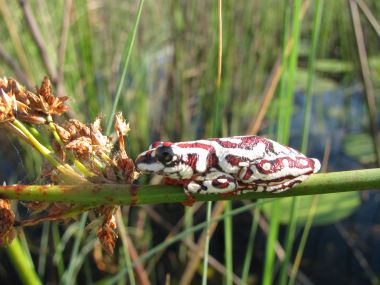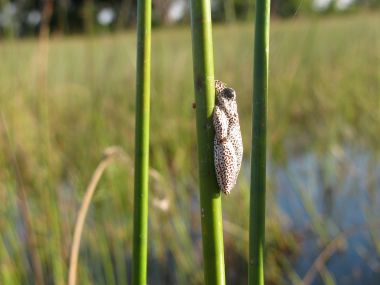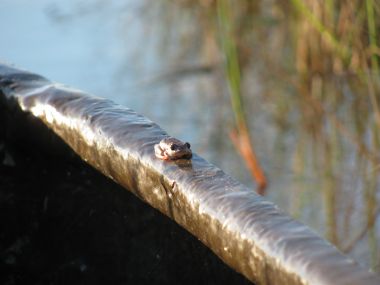About this entry
You're currently reading "Frogging and frogging safaris" an entry on Kate Turkington
- Published:
- 04.02.14 / 10am
- Category:
- Travel
Frogging and frogging safaris

Painted reed frogs may be tiny but are jewels of the waterways
You can go frogging at Chrissiesmeer in Mpumalanga, Jock Safari Lodge in Kruger National Park, or at Amakhosi Lodge in KwaZulu-Natal. Surf the net for other options. Here is the first article I ever wrote about frogging published in Africa Geographic a few years ago. I don't have a print-out of the article, but this is the story...
“HEY DIDDLY DEE, A FROGGER’S LIFE FOR ME”, croaks Kate Turkington as she wades the pans, pools and puddles of Amakhosi, the Place of Kings, in Northern Natal
Rockhopper penguin colonies in the Falklands? Nah! Eyeballing gorillas in Uganda? Nah! Hippo hunting on the banks of Nigeria’s Cross river? Nah. Swimming with the dolphins in Cuba? Nah. Eating squirrels’ knuckles in downtown Beijing? Nah. Been there done that. But a frogging safari? A frogging safari? I re-read the invitation carefully: “The time has come for you to pack your bag, grab your camera and gumboots and head off to Amakhosi Lodge for the frogging safari of a lifetime.”
And so it was, in the dead of night, with a lion or three roaring in the distance, a pair of astonished Spotted Eagle owls monitoring the situation, and with Vincent “Kermit” Carruthers, South Africa’s Frog Man, and Alwyn Wentzel, chief guide and local frog fundi at Amakhosi, nominally in charge, that our intrepid party of journalists, waded into action.
Mission? To find, catch and identify as many of the hopping critters that we could. With belt packs full of plastic bags (in which to pop the frogs temporarily for better scrutiny and identification), headlamps fixed firmly to our sweating brows (but mercifully no canaries), we become swamp tha-angs, splashing, slipping and sloshing through unknown muddy waters (which for all we knew were crocodile-infested). Eddie Koch, Travel Editor of The Mail & Guardian, momentarily loses his environmental balance as his left leg disappears into a deep hole. Unfazed, he empties out his gumboot in a cascade of water as Alwyn discovers our first frog – a Plain Grass frog. Not exactly mind-bending stuff, but its series of rapidly repeated trills make up for its unprepossessing appearance. Gwen Conlyn, her camera clicking in direct competition with the high pitched explosive clicks of the Bronze Caco, leans on the strong arm of Graeme, her husband, legendary pilot with National Airways, who flew us to Amakhosi from Jozi, and made the best bush landing in the world. Alf Hayter, Chief Sub of The Sunday Independent, is awestruck into almost inarticulate silence. “They’re so small, they’re so small,” he emits faintly, overcome by the froggy wonder of it all. James Clarke, neatly stepping over hidden watery obstacles as if he is always doing this sort of thing, peers at a Snoring Puddle Frog, a bright brown little number covered in knobs and contusions. The noise it makes is wondrous beyond belief, a repeated nasal snore, out of all proportion to its tiny size, and evoking instant recognition from the ladies in the group who mutter unkindly about sleeping partners. The clear, liquid “quoip” of the Bubbling Kassina, an oh-so-familiar sound in our South African bush, adds syncopation to the nighttime chorus, whilst our collective favourite, the Painted Reed frog, hits the high notes in short, piercing whistles.

Painted reed frogs come in all sorts of colours but are only the size of your fingernail
The Golden Leaf-folding frog, a tiny, exquisite thing, only as big as your fingernail, sits on a long stem over the water, and after fertilizing the female’s eggs, delicately folds the edges of the leaf over the sticky substance and seals them in against predators. We examine the egg-white meringues of the Foam Nest frogs, but fail to find the red and black striped Banded Rubber frog. Caveat. Never kiss a Banded Rubber frog. It exudes a neurotoxin which is so venomous that you may never get to be a princess. Someone breathes garlicky breath (it was a memorable pre-frogging bush braii) into a plastic bag and in goes a Painted Reed frog, which with its bright colours and glittering, knowing eyes, looks like an escapee from a Disney animated movie. Move over Nemo. It survives its temporary incarceration, although hops rather unsteadily away. It’s a night of pulsing stars and newly recognized calls; a night where we have been privileged to learn yet more about the natural world around us.
“Frogging,” Vincent reminds us, “is not just about frogs. It’s about exploring wetlands, listening to the sounds of an African night, observing and conserving the natural world.” We nod in unison as the owls softly hoot their approval.
Amakhosi, a superb five-star lodge of six huge chalets on the banks of the Mkuze river, has more frog species than the whole of Europe. Wow! There are 18 families of frogs in the world, nine of which occur in South Africa. Each species has a unique call to which the ear of the female frog is specifically tuned (calls from a 30mm frog can travel up to a kilometer), and the males defend their call sites rigorously, repelling boarders by scratching, kicking and boxing. The amazing Giant Bullfrogs, which burrow beneath the ground for most of the year, entombed in a horny carapace the thickness of a fingernail, is especially fierce – the Schwartzenegger of the frog world. They will drown their prey (anything from fellow frogs to small birds, insects and rodents) or bite or suffocate them. And yet they are Superparents, defending their balls of frogspawn and tadpoles fearlessly, even digging tunnels in times of drought from one water source to another along which to shepherd their froggy flock.
Wet, tired, muddy, but overjoyed and enthused by our new experience of a world we were only previously dimly aware of - we head home for hot showers, air-conditioned comfort and soft beds. But the gum boots are there waiting for you…

This painted reed frog hasn't yet found his true colours...
Infotravel
Amakhosi Lodge, PO Box 354, Pongola, 3170, South Africa
Tel+27 34 414 1157
Eeail info@amakhosi.com www.amakhosi.com
Vincent Carruthers’ superb field guide, Frogs and Frogging in Southern Africa, published by Struik, includes a CD featuring 56 frog calls